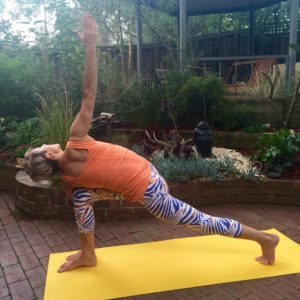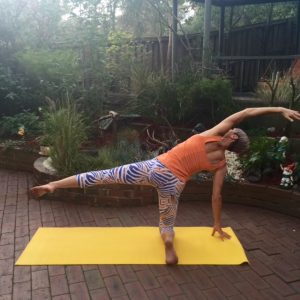Do you want to revitalise your body, mind and spirit after this long winter? Do you long for the time when you were able to get out of bed in the morning with vitality? Do you wish you could go through your day with more vim and vigour? Then an asana yoga practice tailored to the seasons will be for you. In all our group yoga classes we allow the energy of the season to play some part in the sequencing and in the choices of yoga poses. See if this choice of 7 spring yoga poses will resonate with you. No need to limit your practice to those 7 though. Step on your mat and explore. Remember to FEEL into your body, breathe evenly and calmly. Always move within your body’s limits and abilities. For any medical concerns and conditions, please see your medical practitioner. Please modify as you need to. All seven poses described in detail would warrant an article on their own. Enjoy and have fun! And respect the two boundaries of yoga:
- breath – stop, or modify, if your breath gets short, sharp, or if you hold your breath.
- pain – if you feel pain, stop or modify. Regular yoga practice will allow you to learn the difference between strong discomfort and pain.
According to Traditional Chinese Medicine, the Five Element Theory, the body is made up of the same five primary elements that exist in nature. These are Wood, Metal, Fire, Water and Earth. These elements are linked to different organs and energy channels (meridians) in our bodies. In spring the wood element is strongest, which relates to the organs and meridian pairs of liver and gallbladder. Anything we do to help balance and support these organs, will be extra beneficial during spring. Think spinal twists, prone backbends and strong forward bends to stimulate the liver. As the liver meridian runs along the inside of the legs, and the gallbladder meridian along the outside of the legs and the side body, yoga poses that stimulate these areas are largely beneficial.
Reclining butterfly, reclining cobblers pose – Supta Baddha Konasana

You can either start or finish your practice with this position. Find a comfortable lying down position, clasp your hands and allow the palms to support the back of your head. Allow your elbows to soften and gently open towards the floor. This will allow the front of your chest & shoulder joint to open and stimulate more energy lines on the inside of your arms. Then bend your knees and bring the soles of your feet together, allowing your knees to gently open out to the side. This will externally rotate your hip joint and stimulate the energy channels of liver (yes kidney as well). Notice where you feel sensation. This could be inner thighs, groin area, lower back, perhaps outer thighs, buttocks or ankles. No right or wrong here. Notice what you notice and breathe softly. If this is the start of your practice, set your intention, thank yourself for being here, for fostering your health and wellbeing. Stay for a few breaths or a few minutes, depending on your time availability and your intention.
Half pigeon pose, sleeping swan pose – Eka Pada Raja Kapotasana

A traditional ‘hip opening’ pose. You can step into it from Downward facing Dog or from tabletop. Bring your right knee to the right of your mat and your lower leg as parallel to the front edge of your mat as is comfortable. You may want to keep the heel underneath your thigh. Do experiment and move in a way that feels good to you. Extend your left leg back. Lift your upper body, and feel the front of your hips yielding towards the floor evenly. If you need to, slowly lower on to your forearms, perhaps all the way forward. Let your forehead rest. This may produce a physical sensation around your right buttock; right outer thigh, lower back and even your left leg hip flexors and quadriceps. Notice sensation and see if you can surrender into this position with muscular ease. This is deeply nourishing for your hip joints, your pelvic and groin area. Breathe evenly and calmly. See if you can use your exhale breath to soften where you feel the physical sensation the most. Stay present. Hold for a few breaths or a few minutes. Enjoy and don’t forget to do the other side. Remember the purpose here of stimulating inner & outer leg. Can you feel the benefit?
Head to knee pose – Janu Sirsasana A

Can you see why I choose this asana? Yes, it is a deep forward bend from the hips, stimulating the digestive organs. Both, the inside and the outside of the legs are stimulated and it is one of the more classical seated forward bends.
From Dandasana bent your left leg and bring the sole of that left leg gently against your right thigh. Then with breath and your bandhas engaged bend forward from the hips. Place your hands somewhere alongside your lower leg, or hold your feet, or even bind. Bend only as far forward as you can from your hips with a straight spine. Avoid rounding forward. Remember this is with the intention to stimulate the liver. So if you flex (round) your spine, in a more yin-like way, that is not wrong, it simply will serve a different purpose. Always know what your or your teachers’ intention is. So there will only ever be a safe and an unsafe way, never a wrong or right or better or worse way to practice yoga asana. This is an active pose, keep your straight leg engaged, and keep moving the heart & chest forward and the shoulders back and down. Stay for 5-20 breaths. Let your breath and your body guide you. Enjoy and change sides.
Revolved head to knee pose – Parivrtta Janu Sirsasana

Can you feel the deliciousness of this pose? A wonderful lateral side bend and stretch for your quadratus lumborum, a deep postural muscle in your lower back.
Here, in addition to the stimulation of the inner thighs, you get this beautiful stimulation of your side body. And remember that is where the gallbladder meridian runs along. Of course moving your spine in all possible planes is beneficial in any season.
You set up as previous pose, bring your left forearm or hand (the arm or hand of the straight leg) along the inside of your left leg (the straight leg). Sit up tall and twist your torso from the belly to your bend leg (the right in this case). Then use your left arm as a lever working against your straight leg as you keep your chest open, and slowly bring your side body of the straight leg (here the right) sideways towards your straight leg. Lastly bring your right arm overhead and either hold on to your left foot, or bend at the elbow, bring your hand behind your head for support and actively point the elbow toward the sky. Keep breathing evenly; keep your bandhas engaged and your straight leg active. This is an active position and you may only choose to hold it for a few breaths. Change sides and enjoy.
Twisted crescent lunge – Parivrtta Anjaneyasana

Twisting and balancing. What a glorious combination. Twist for detoxification and balance for tremendous focus. Two favourable spring qualities. Can you see & feel the inner & outer leg, groin, hip and outer body stimulation for our spring meridians here?
Come into your high lunge. Drop your back knee to the floor anytime you feel the need to. Bring your hands into prayer and twist from your waist towards your front bent leg. Stay and breathe with bandhas engaged. Or, if the space is there release one hand down and one hand up, further increasing the twist, the opening in the chest and length in your spine. Or you can simply bring both hands onto your front leg. Listen to your body. Enjoy this strong pose. Hold for 5-20 breaths and change sides.
Gate pose, bend to straight leg – Parighasana

Yes, you can see and feel a theme emerging by now.
You can put this and the next pose at the beginning of your practice as a gentle start. Or put it at the end to feel the progression and the degree to which your body opened and yielded since the start. And then celebrate.
Come to kneeling; bring your left leg straight to the side. Feel if toes forward (like here) or pointed to the side works best for your body. Lift your torso, engage your bandhas, find length and then with breath slowly bring your right hand above and over your head, and your left hand to your straight leg, opening and leaning your torso to towards the left, the bend leg side first. Try not to collapse here, keep the front of the torso open and the back of the torso long. Breathe evenly, notice sensation, stay present to thought, emotions, and feelings and always come back to noticing your breath. Breath is key. I know you know. Enjoy this beautiful pose. Stay present and active for as long as you can, perhaps 5-20 breaths.
Gate pose, move to bent leg – Parighasana, variation

From the previous pose, simply come up and bend over towards the other side, the bend leg side. You may need to bring the floor up higher with a block, bolster, and book, whatever stable you have, to rest your fingertips or your palm on.
You can keep your straight leg on the floor, or, as here, lift the leg, keep it there or practice some pumping actions to further stimulate your belly, your inner and outer leg. Of course you keep your bandhas on, keep the breath evenly and only move in a way that supports you. Challenge yourself yes, but don’t hurt yourself. Enjoy, stay for as long as you feel you can and change sides.
Have you remembered to keep your inner smile and outer smile?
Have you made sure you enjoyed your practice? Could you find an element of joy, lightness or / and playfulness? Did you modify as you needed to? Could you allow yourself to shine and to explore your potential? High 5 to you. Now celebrate! And remember, next time you step on the mat, you will be a different person, the practice will feel different, we are not robots. Now take rest with Savasana, or continue practicing.
Always finish your practice with 3-7 minutes of Savasana – Corpse Pose. Or in our case here, perhaps finish with the first asana on page one. Simply taking rest at the end of practice. Allow your Nervous System and your heart rate to slow.
Please take from this what resonates with you. Let’s not be too concerned if toes point this way or that. Keep yourself safe; allow your own intuition to tell you what’s supportive for you and what’s not. Often the hang ups on details are simply procrastination in disguise. Simply step on the mat, smile, breathe and move. I know you know, I needed the reminder.
Enjoy the season of revitalisation and make the most of what you can do and what you do have. Please let me know how you found these suggestions. And if you have any questions or requests, let me know too.
See you on the mat.
Namaste
Bettina
